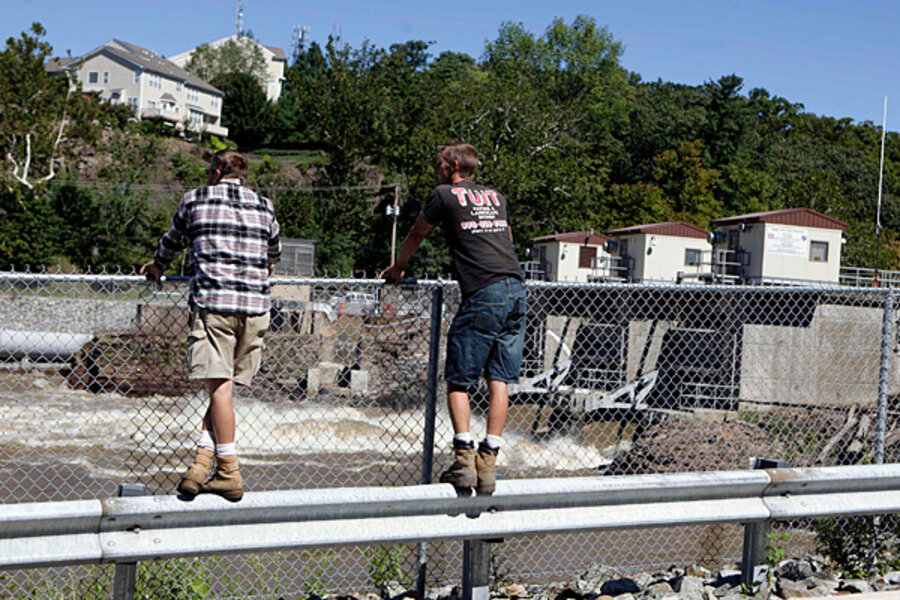Aftermath of Irene: budget-straining cleanup and lives 'turned upside down'
Loading...
| Atlanta
North Carolina saw its necklace of barrier islands, threaded by Highway 12, cut straight through in five places by hurricane Irene's storm surge. Vermont, with no exposure to the Atlantic Ocean, somehow got the brunt of the massive storm, with an iconic 141-year-old covered bridge claimed by the Williams River. More than a dozen full heating-oil trucks were pulled into a river near Tuxedo Park, N.Y., spilling oil into raging waters.
To be sure, the majority of the East Coast shrugged off the lumbering storm. Although it battered the shore from South Carolina to Massachusetts, the somewhat mild ferocity of the storm left cable-news networks facing criticism for creating a "hurricane of hype" with their predictions of potential Armageddon in New York City.
Yet Irene wasn't exactly milquetoast, either. While forecasters are debating what went wrong with an intensity forecast that overshot the true power of the storm, Irene left a deep mark on hundreds of coastal and mountain communities now beginning a massive cleanup. Millions of customers are awaiting the restoration of power, and some 2.4 million evacuees want to get safely back home.
An estimated 35 Americans died in incidents connected to the storm, and 10,000 flights were canceled. Storm costs, some of them to be borne by a cash-strapped Federal Emergency Management Agency, could reach as high as $10 billion. In contrast, hurricane Katrina's damage tally topped $80 billion.
"There's still lots and lots of destruction, and people's lives are turned upside down," said North Carolina Gov. Bev Perdue (D) after surveying damage to the fragile Outer Banks. There, Irene's storm surge left the islands of Hatteras and Ocracoke cut off from the mainland.
One legacy of the storm is that it may put an unwelcome crimp in the budgets of coastal communities, already reeling from the nation's economic slump, as they begin to clean up. The crucial Labor Day weekend is likely to be a bust in some areas like the Outer Banks, where large parts of the popular holiday beaches are inaccessible.
"It's not good timing," Chuck Watson, research director for Maryland-based Kinetic Analysis, told USA Today. "The state of the economy makes this a bigger storm than it would have been."
With the storm's strength fading before it hit the North Carolina Crystal Coast on Saturday morning, wind and storm-surge fears largely diminished. And New York, which saw its first-ever hurricane evacuations, remained largely dry and undamaged.
Other cities didn't fare so well. Parts of Hoboken, N.J., flooded.
But it was the rolling mountains of Vermont, the last state to declare a state of emergency, and the New York Catskills that may have taken the brunt of Irene. Five-hundred-year-flood conditions in Greene County, N.Y., left many communities impassable on Sunday as bridges washed away. Eighty-seven people had to be rescued in Prattsville, N.Y.
Problems remain in New Jersey as well, where officials are expecting record-breaking flooding in the Passaic and Ramapa watersheds.
The danger of flash floods is decreasing across the affected region, but larger rivers may continue to rise, said FEMA director Craig Fugate in a Monday briefing. FEMA hydrologist David Valley confirmed that parts of New York and Vermont saw record-breaking floods.
The lack of major flooding in New York City resulted in at least one welcome development: Wall Street opened business Monday with a surge in stock prices on news that Irene didn't cause the kind of damage that many had feared.
The official damage report on the storm will, however, have to wait. It will take at least 72 hours to tally the breadth of the destruction, said Mr. Fugate of FEMA on Monday morning.
As the Gulf Coast on Monday marked the 6th anniversary of hurricane Katrina's landfall in 2005, Fugate said in an afternoon briefing that preparation for hurricane Irene reflected lessons learned from that storm, which killed 1,800 Americans.
What national responders learned was, "We can't wait to know how bad it is before we get ready," said Fugate. "We have to go fast and we have to make decisions based on what the potential impacts might be."





